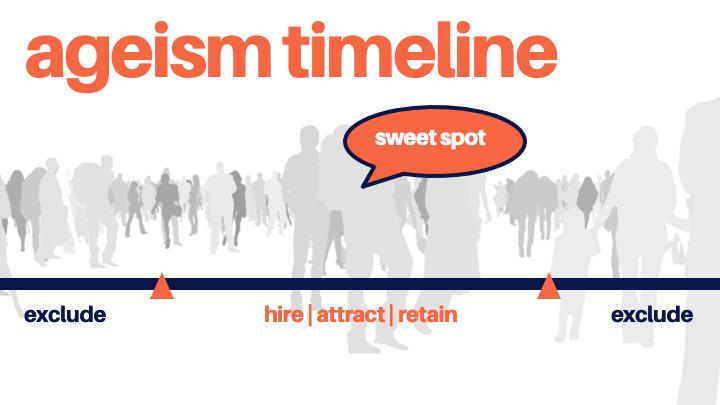Imagine you’re hiring for an executive position at a large company. You’ve outsourced the recruiting to a high-profile headhunter. They ask you what you are looking for in a candidate. When you think of the perfect fit, are you only thinking of experiences and skills? Or, do you also automatically conjure a picture with physical attributes like race, gender and age?
According to cognitive neuroscientists, 95% of our mental activity is by default, so most of our decisions, actions, emotions and behavioral responses depend on the 95% of brain activity beyond our conscious awareness. That means our default biases will often predict the steps we take. It also means that bias is part of human nature.
Awareness, however, needs to be developed to ensure these natural tendencies do not lead to unintentional discrimination. And while most people understand the importance of inclusive hiring practices for race and gender, they often overlook age.
The Ageism Timeline
The ageism timeline is depicted with a mythical sweet spot that excludes talent on both sides of the age spectrum. Younger workers are excluded from workplace opportunities because they lack experience, completely discounting the demonstrated potential to learn and adapt. Older workers are denied opportunities due to many stereotypes and assumptions disregarding their experiences and present career desires.
For younger employees, age bias results in low morale, mistrust and an increased flight risk. For those older, years of accumulated expertise are suddenly considered over-rated and over-priced. The value assigned to work ethic, dedication and loyalty plummets as leaders look for younger, cheaper talent to call on 24/7.
As the ageism timeline suggests, younger workers move into a period where age is not a liability. Unfortunately, with time, they age into it again.
The left side of the ageism timeline offers a long runway to recover. The right side of the timeline provides no such relief.
The implication is ominous. Unless younger workers want to age into an ageist future that never ends, they must join older workers to demand a genuinely diverse, age-equitable workplace.
Proof of this was seen during the COVID recession when people between the ages of 16 and 24 and over 55 had the highest unemployment rates.
How to Become an Age Advocate
To combat workplace ageism, employers must actively address the issue by making it a critical part of the DEI plan. That requires teams to proactively survey, analyze and train the workplace to understand how age bias and stereotyping impede business success.
Studies show that older workers are less likely to speak out against ageism. Younger workers, however, are more vocal.
It takes everyone advocating for age equity and inclusion to create change. At the individual level, several action steps that can make a difference.
- Recognize when you allow age to influence personal thoughts and actions–whether directed at yourself or others. Do you hear yourself thinking someone is too old or too young? Ask yourself what makes you think age is a factor in ability, then ask if your beliefs are true. Most likely, it is an assumption, not reality.
- Watch your language to avoid inadvertent ageist references. Don’t refer to younger workers as kids or older workers as over-the-hill or out-of-touch. Job seekers and employees deserve the same level of professionalism and respect, regardless of perceived age.
- When you see evidence of ageism, speak out. It can be as easy as asking, “Why is age relevant in this situation?” That is often enough to make others aware that age bias or stereotyping has influenced the conversation and that it’s time to step back and re-evaluate.
For more guidance on eradicating ageism across the age spectrum, refer to the Global Report on Ageism, a joint report by the United Nations and the World Health Organization. The 200-page report defines various ways ageism manifests in younger and older people. The report summarizes the most effective strategies to reduce ageism. Finally, it issues a call to action for all ages to eradicate the one ism potentially impacting everyone.
Read the full article here






